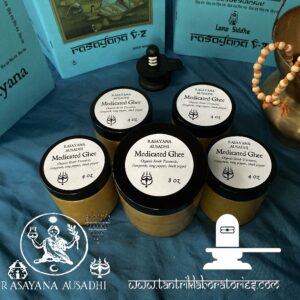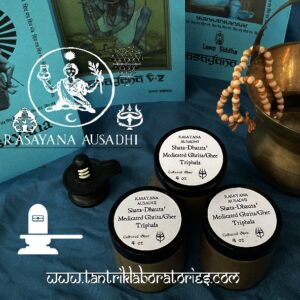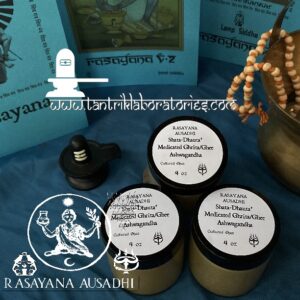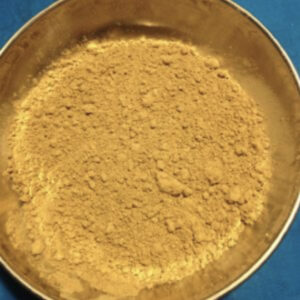Erode Turmeric is known for the high Curcumin making it the most coveted for medicinal use. We infuse organic, cultured ghee using the traditional Ayurvedic methods of slow, low heat, purifications in water and washing, that culminate in the purest, finest and most bioavailable product.
Our organic herbs are infused into Grassfed Organic Cultured Ghee in our artisan line of small-batch traditional made in traditional copper vessels. We started this line with the Master Siddha herbalists of Ayurveda to produce the apex of medicated ghee or ghrita for maximum bioavailability. Indian or Desi ghee is the traditional Indian ghee made from cow’s milk that is first collected and saved for a few days to “culture”. The cultured milk is then churned to produce butter. Churning separates the emulsified fats in the milk from the liquid or aqueous portion of the milk. This is the most medicated ghee which is then washed and cleansed.
These are the best, efficient and bioavailable means of delivering herbal formula deep into the body, and are especially useful in gut health. Thus, this product is truly a yogavahi—a catalytic agent that carries the medicinal properties of herbs into the seven dhatus or tissues of the body. Ghee pacifies pitta and vata and is acceptable, in moderation, for kapha. Charaka Samhita. This means that they only produce their ghee from cultured butter, also known as Makhan. Makhan is made by transforming cream from cows (which are revered and considered sacred in India) into yogurt and then by churning the yogurt into butter. From there, cooking small batches of the cultured butter over an open flame to clarify the butter into ghee. This process of clarifying butter into ghee removes the milk fat solids, casein and lactose from the butter leaving only the healthy, ojas building fat which is known as ghee.
This process is called ‘Murcchana’ samskara (fat processing) is assumed as one of the crucial step in ghrita preparation entailing the use of ‘Murcchita’ ghee i.e. ghee prepared with incorporation of Murcchana herbs y ghritapaka (ghrita preparation), ghee should undergo ‘Murcchana’ samskara to enhance the medicinal potency of a ghrita and to get rid of bad odour and rancidity. ‘Shata-Dhauta’ is a process involves washing of purified ghee one hundred times with water which increases stability of ghrita and makes it elegant and suitable product for topical application cow ghee increases the potency of certain herbal ingredients by carrying the lipid soluble active components to the interior of the cell Ayurvedic texts. Briefly, the stated quantity of ghee (Sneha Dravya) was poured in a large stainless steel vessel and allowed to melt under moderate flame. Further, the plant extracts (Kalka) in equal proportion, water (Drava Dravya) and molten ghee (Sneha Dravya) were combined in specified ratio of 1:16:4 respectively in same vessel and boiling was initiated till the complete evaporation of moisture and appearance of characteristic features of ghrita. The whole process of ‘Ghrita Paka Kalpana’ was carried out on mild to moderate flame and continued until ‘Sneha Siddhi Lakshana’ was obtained. The ‘Sneha Siddhi Lakshana’ is of burning of paste (Varti) without crackling sounds and disappearance of froth (Phena) in ghrita To increase therapeutic quality, purity, efficacy and stability/shelf life, the prepared PHBG-I was optimized by processing with ‘Murcchana’ and ‘Shata-Dhauta’ samskara as per the ancient Ayurvedic procedures.
This batch is infused with fenugreek soluble fiber, also known as galactomannan, and long pepper/black pepper all of potentiate and increase the potency, bioavailability or absorption of the healing properties of Turmeric, as proven in many clinical studies. This combination with ghee is the absolute supreme method of ingesting this near miracle herb.
Haldi, Manjal, Curcuma longa Turmeric is a plant that has a very long history of medicinal use, dating back nearly 4000 years. In Southeast Asia, turmeric is used not only as a principal spice but also as a component in religious ceremonies. Turmeric is full of bioactive compounds, antioxidants, and boosting immune and neurotrophic factors essential for brain function. It is so good for skin, digestive aids, in smoothies, in ghee, mixed into rice for a golden rice and curries. It is a potent anti-inflammatory for chronic pains and issues, lowers risk of heart disease , arthritis, and even mood. It is used in many Siddha and Ayurvedic and Yogic diets, fasting, and toning the stomach and digestive tract. It ius used in formula to expel phlegm or kapha, as well as to open blood vessels in order to improve blood circulation. It can be incorporated into foods, including rice and bean dishes, to improve digestion and reduce gas and bloating. It is a cholagogue, stimulating bile production in the liver and encouraging excretion of bile via the gallbladder, which improves the body’s ability to digest fats. Sometimes, turmeric mixed with milk or water is taken to treat intestinal disorders as well as colds and sore throats. Traditional uses hail it for strengthening the overall energy of the body, a digestive aid, dispelling parasites, regulating menstruation, dissolving gallstones, and relieving arthritis and for inflammation of all kinds. In Ayurveda it is said to balance the three doshas (vata, pitta, and kapha). It aids in removing ama ( Ama means toxin or undigested metabolic waste), and it is a lekhanya (scrapes accumulations) of toxins, biofilms, wastes in the blood and digestive tract.
It is a potent rasayana aiding in longevity and general health, it aids in the balancing of the rasa and rakta dhatus (the blood and plasma of the circulatory system)It is both an exoteric herb of Agni (digestive fire) and is said to impart sense of well-being, calm, aids in meditation, in breathing exercises. It is neuroprotective, with antioxidant and potent antiseptic and anti-bacterial properties and is one of the most clinically studied herbs in the world. As a potent detox herb, it aids in cleansing the liver as well in treatment of diabetes. Modern in vitro studies reveal that turmeric is a potent antioxidant, anti-inflammatory, antimutagenic, antimicrobial, and many other uses, see Rasayana V.3.
To take ghee as a supplement, dissolve 1/2-1 teaspoon ghee in 1/2 cup warm water and drink it on an empty stomach. Cultured ghee is more refined and subtle than regular ghee, and thus able to penetrate deeply into your cells to deliver nourishment.




 Adding...
Adding...